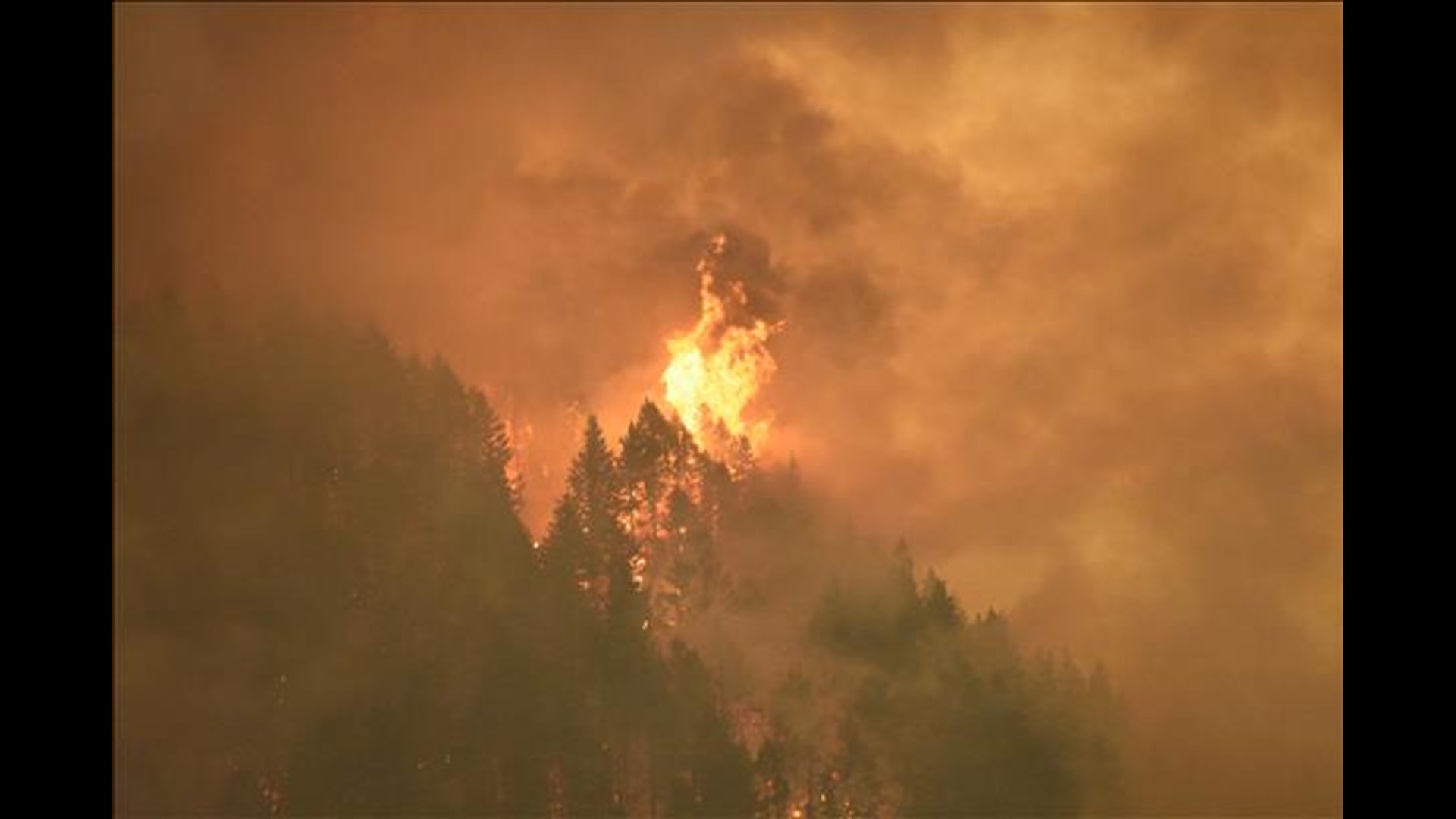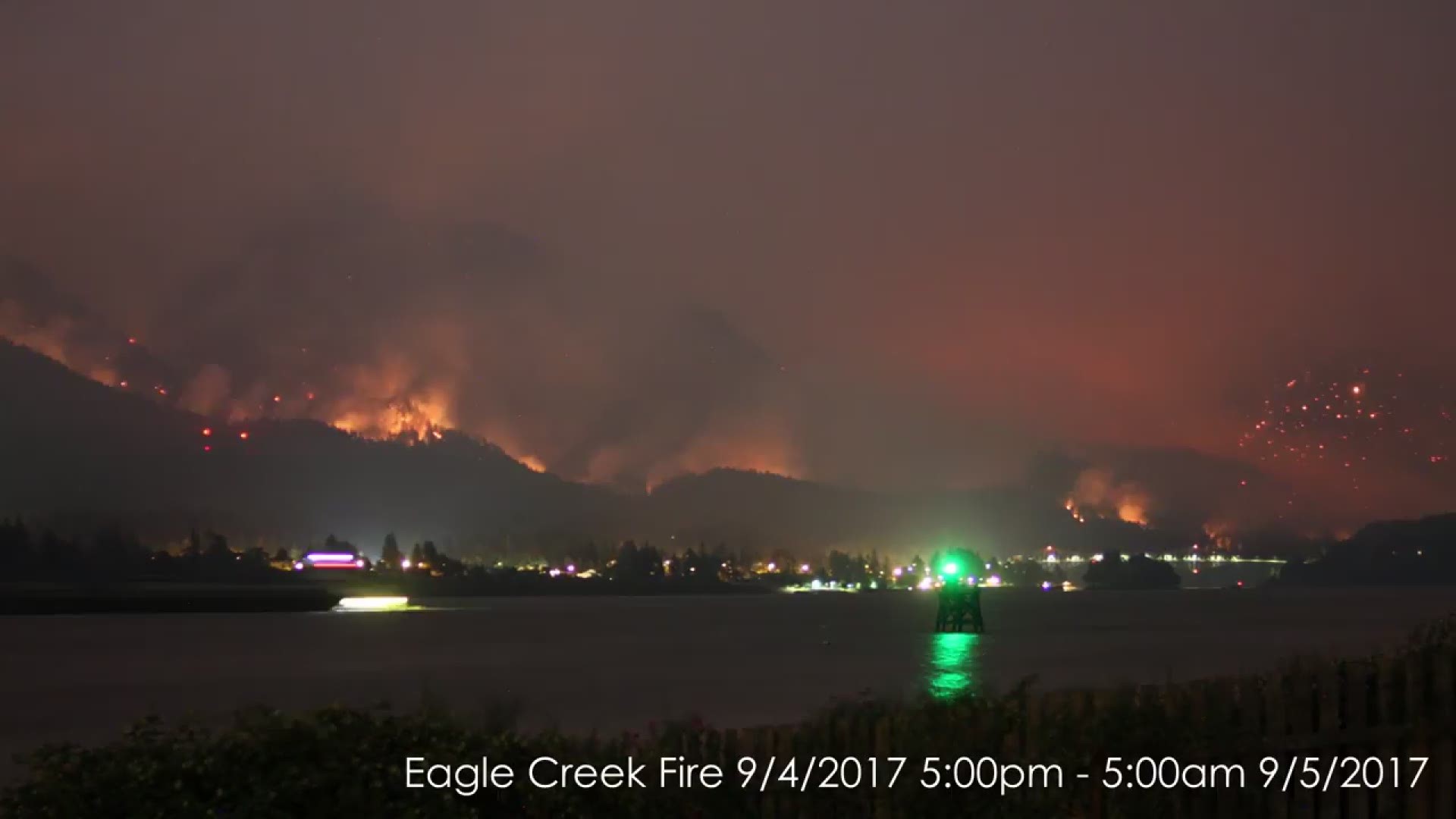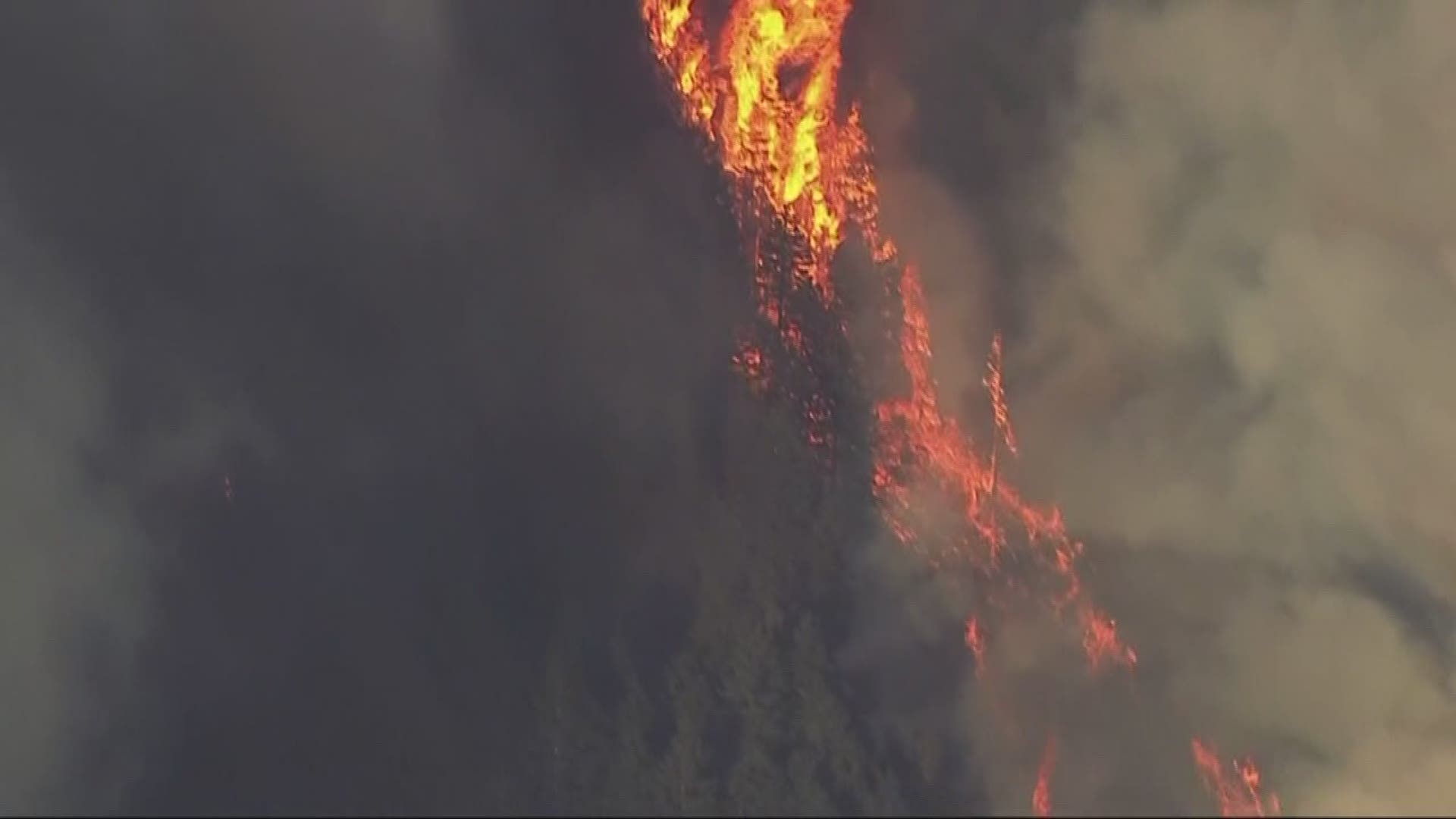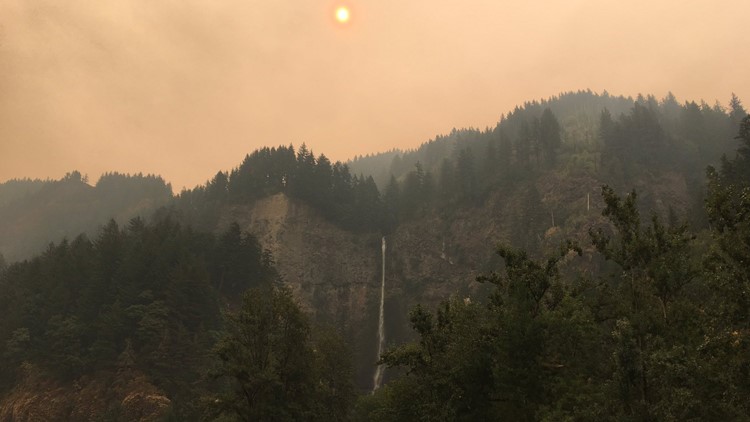Engulfed in flames: What we know about wildfires burning the Northwest
More than two dozen wildfires are burning hundreds of thousands of acres across Oregon and Washington.

Published Sept. 5, 2017. For the latest fire sizes, containment and evacuations, click here.
PORTLAND, Ore. -- Although September has rolled into the Northwest, fall weather feels far away as wildfires rage across the region, threatening homes, closing roads and torching iconic natural areas from southern Oregon to northern Washington.
Firefighters from federal, state and local agencies are pushing back against flames with little help from mother nature. Temperatures remain sweltering after a historically hot and nearly rainless summer. A hint of rain in the forecast could dampen flames but brings added threats of lightning storms.
Meanwhile, residents from southern Oregon to the Seattle area watch as the sky fills with acrid smoke. Ash falls like snow, dusting cars and roads with remnants of the hundreds of thousands of acres of forest land that has burned so far with no end in sight.
This is what we know about what’s burning, what’s threatened, what caused the fires and when we might get some relief.
What is burning
As of Thursday, more than two dozen named fires are burning in Oregon and Washington, most of which run like vertebrae up the Cascade Mountain Range from northern California to southern Canada. The biggest fires are pushing thick smoke into the Portland, Seattle, Bend and Brookings areas.
The Gorge
The Indian Creek Fire has been burning hundreds of acres north of Lost Lake since early July, but on Sept. 2 the Eagle Creek Fire sparked near the town of Cascade Locks and quickly surpassed the smaller blaze. As of Thursday, the Indian Creek and Eagle Creek fires combined and were burning about 33,000 acres along some of the most popular trails and waterfalls in the Columbia River Gorge and in the Mt. Hood National Forest. It was considered to be about 5 percent contained Thursday morning and a change in winds was pushing the fires east toward Cascade Locks and Hood River.
Overnight Monday at the end of the Labor Day weekend, the fire jumped the Columbia River and sparked on the Washington side of the river. That new blaze has been named the Archer Mountain Fire. On Wednesday, it was burning a little more than 100 acres in Washington state.
The Eagle Creek Fire is the main culprit of unhealthy air quality and ash in the Portland area.
On Tuesday, residents in the Portland metro area awoke to an unsettling scene of ash blanketing the ground. Air quality has repeatedly diminished to unhealthy ratings as winds push smoke west from the gorge. Winds shifted Wednesday to blow east through the Gorge, leaving Portland with less smoke and ash. Air quality was still rated unhealthy Wednesday in the Portland area but was starting to clear by Thursday as rain ended.
Southern Oregon
Nine named fires surround Medford in Southern Oregon. The largest is the Chetco Bar Fire, burning more than 176,000 acres as of Wednesday near Brookings. The fire was so significant that at one point in August it was determined to be the highest priority wildfire in the country. It led to the relocation of season-opening high school football games in areas with unhealthy air conditions.
The Umpqua North Complex Fire is also burning near Roseburg, taking up more than 31,000 acres.
Central Oregon
Central Oregon has recently experienced some of the poorest air quality conditions in the country, mainly from the Milli Fire raging near Sisters. The fire started on Aug. 11 and at 24,000 acres continues to choke Sisters, Bend and Redmond.
In all, more than a dozen named fires are burning in the Willamette National Forest.
Washington
The East Crater Fire in Gifford Pinchot National Forest was burning around 1,000 acres Wednesday in Southwest Washington. It started Sunday about 12 miles west of Trout Lake.
Ash also fell across the Seattle metro area, from the Norse Peak wildfire in the Okanogan / Wenatchee National Forest and the Jolly Mountain Fire near Cle Elum.
What is threatened
Thousands of homeowners have been evacuated due to fires across the region. In Oregon, the biggest threat to homes is the Chetco Bar Fire, which has destroyed at least six homes and threatened more than 8,500. In Washington, the Jolly Mountain fire is dangerously close to more than 4,200 homes.
Another 5,200 homes threatened by the Eagle Creek Fire in the gorge. About 400 are under mandatory evacuations. Interstate 84 was closed indefinitely between Troutdale and Hood River as flames licked residential areas and debris fell on the road. The road remained close Thursday as workers alternately worked to control the fire and clear thousands of tree limbs and other debris.
The Breitenbush Hot Springs retreat and conference center near Detroit has also been evacuated through mid-September, as four fires burn close by. At Detroit Lake, residents said “the smoke was actually burning our eyes.”
The Eagle Creek and Indian Creek fires in the Mt. Hood National Forest could threaten the Bull Run watershed, which supplies Portland with clean drinking water. The Portland Water Bureau said that the fires have not approached the drinking water reservoirs or water supply infrastructure and city water continues to be safe to drink. The city said the Columbia South Shore Well Field will act as a backup water supply if needed.
More than 150 hikers on Sunday breathed long-awaited sighs of relief after being stranded overnight by the Eagle Creek Fire. The hikers took a 14-mile detour before reuniting with family and friends.
For some, the threat to beloved natural areas is just as devastating. Many trails and campgrounds in the gorge, the Willamette National Forest and Mt. Hood National Forest are closed. Fire crews from around the state worked tirelessly to protect and save the iconic Multnomah Falls Lodge from burning.
The longstanding Oneonta Gorge tunnel has already burned. Oregon Department of Transportation employee Doug Gross took a photo of the wood-lined tunnel on fire Monday night.
Viewer photos show just how shocking the destruction is from the Eagle Creek Fire in the gorge.
Photos: Smoky skies from Eagle Creek Fire
Viewer Bernadette Price sent a photo of Yeon Mountain on fire in the heart of the gorge.
“I mourn for the incredible loss – a tragedy beyond words,” she wrote.
Hikers who traverse the Pacific Crest Trail next year will also likely see a much different scene, as wildfires ripped through some of the northwest portions of the trail. Currently, the Pacific Crest Trail is closed in parts of Washington, southern Oregon and northern California due to fires.
Portland Fire and Rescue spokesman Lt. Damon Simmons said he drove through the gorge Wednesday morning and the fire had not destroyed everything in his sight.
"It's not a blackened, destroyed no-man's land. There's trees everywhere and they look good. That's not to say there's not damage to some of those trees and they may have to be removed in the future. It's still a dangerous drive out there," he said. "But it's still a beautiful drive through there in the daylight."
Until the smoke clears, no one can say for sure just how widespread and shocking the devastation will be to Oregon and Washington’s natural areas. Some areas may be scorched while others will emerge still full of life. The states are no strangers to wildfire and the forests will likely recover, just as they have in the past. But the impacted natural areas people saw earlier this year will almost certainly look dramatically different after the fires subside.
What caused the fires
Most of the significant fires in the region were a result of lightning strikes, including the Jones Fire, Chetco Bar, Milli and North Peak. The cause of others, such as the Umpqua North Complex, are still unknown and under investigation.
Two fires, the Quarry Fire in Washington and the Eagle Creek Fire in the gorge, were confirmed to be human caused.
Oregon State Police believe the Eagle Creek Fire was sparked by a teenager lighting fireworks on Sept. 2. On Tuesday afternoon state officials said the suspect is a 15-year-old boy from Vancouver, Washington. He and others were suspected of igniting fireworks along the Eagle Creek Trail, which sparked the fire.
The suspect has not yet been named, arrested or charged with a crime.
A witness, Kevin Marnell, told KGW he heard a firework blast when he was hiking on the Eagle Creek trail Saturday. He later saw Oregon State Police talking with a group of teenagers Saturday night near the Eagle Creek trailhead.
“We heard this loud bang -- sounded like a shotgun blast – went down further and saw smoke rising up,” he said.
Another witness told Oregon Public Broadcasting she saw a young hiker who was with a larger group throw a smoke bomb into the woods on Saturday. She later saw billowing smoke from that spot in the woods.
When will the fires end?
Multiple state and federal agencies are fighting the fires in Oregon and Washington, including the U.S. Forest Service, the state departments of forestry and regional fire departments. But containment on most major fires isn’t expected to take place until late September or early October. Fire officials estimate the Milli and Norse fires will be contained – but still burning – by Oct. 1. The Chetco Bar fire is projected to be contained by Oct. 15. The Eagle Creek Fire is projected to be contained by Sept. 30.
So far, firefighters haven’t had much help from the weather, which has remained hot and dry.
This August was the hottest August in Portland since records were first recorded at the airport 77 years ago. The forecast continues to show warm temperatures through the second and third week of September, but they should drop to the upper 70s by Thursday instead of the 90s Oregon saw at the beginning of the month.
There is also a welcome chance of rain on Thursday both in the Gorge and Southern Oregon. But with that could come thunder and lightning, and the added chance of more fires.
Published Sept. 5, 2017






